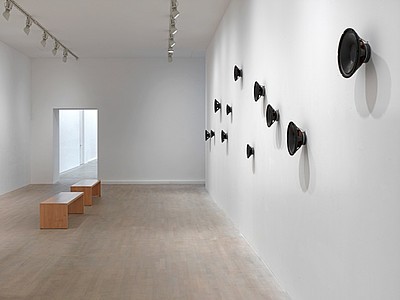Susan Philipsz
The Missing String
09 Nov 2013 - 06 Apr 2014
In recent years, the Scottish artist Susan Philipsz – who refers to herself as a sculptor – has earned an international reputation for her striking sound installations. With The Missing String, Philipsz – a recipient three years ago of the prestigious British Turner prize – will be a guest in the bel etage of the K21 of the Kunstsammlung Nordrhein-Westfalen from November 9, 2013 until April 6, 2014. This will be the first time this artist – who was born in Glasgow in 1965, and lives today in Berlin – has had an exhibition at the Kunstsammlung.
Occupying the boundary between visual art and music, Philipsz’s space-filling sound installation alludes to a number of earlier exhibitions that took place in the impressive galleries of the Ständehaus. In this project, she raises questions about the setting’s historical context and about practices of conservation and collecting.
A trained sculptor, Philipsz is interested primarily in the interplay between sound and space. “For me, it is a question of the way in which the emotional and psychological effects of sound can enhance our awareness of the space we occupy,” explained the artist in a newspaper interview conducted in 2010.
Through the deconstruction and rearrangement of sound and its localization in space, Philipsz effects a continuous redefinition of both media. Her handling of historical materials betrays an almost archaeological interest in that which is concealed, its multifarious potential conveyed through her work in striking ways to evoke a range of sensations and recollections. In her audio works, she employs the rock music of the 1970s, along with Scottish sea shanties and the “Internationale.” The basis for her 2012 project for documenta was an orchestral work that was composed in 1943 in the concentration camp at Theresienstadt, and premiered there as well.
The point of departure for The Missing String, created especially for the Kunstsammlung, is the artist’s wide-ranging research into the subject of the war-damaged musical instruments found today in numerous collections throughout Germany. They constitute a striking emblem of the destructive fury of war, and mirror the often tragic fates suffered by artists during the National Socialist dictatorship. The search for these testimonials of wartime experience, many of which have vanished into archives and storage depots, allows Susan Philipsz’s work to become a genuinely revelatory act.
For the production of The Missing String, she was able to use an entire series of war-damaged instruments, thereby employing them for their original purpose – to make music – for her recordings. Battered, displaying bullet holes, twisted out of shape, each narrates a different, moving story: simultaneously historical objects and musical instruments, their sound quality shaped in unavoidable ways by the impact of war.
Occupying the boundary between visual art and music, Philipsz’s space-filling sound installation alludes to a number of earlier exhibitions that took place in the impressive galleries of the Ständehaus. In this project, she raises questions about the setting’s historical context and about practices of conservation and collecting.
A trained sculptor, Philipsz is interested primarily in the interplay between sound and space. “For me, it is a question of the way in which the emotional and psychological effects of sound can enhance our awareness of the space we occupy,” explained the artist in a newspaper interview conducted in 2010.
Through the deconstruction and rearrangement of sound and its localization in space, Philipsz effects a continuous redefinition of both media. Her handling of historical materials betrays an almost archaeological interest in that which is concealed, its multifarious potential conveyed through her work in striking ways to evoke a range of sensations and recollections. In her audio works, she employs the rock music of the 1970s, along with Scottish sea shanties and the “Internationale.” The basis for her 2012 project for documenta was an orchestral work that was composed in 1943 in the concentration camp at Theresienstadt, and premiered there as well.
The point of departure for The Missing String, created especially for the Kunstsammlung, is the artist’s wide-ranging research into the subject of the war-damaged musical instruments found today in numerous collections throughout Germany. They constitute a striking emblem of the destructive fury of war, and mirror the often tragic fates suffered by artists during the National Socialist dictatorship. The search for these testimonials of wartime experience, many of which have vanished into archives and storage depots, allows Susan Philipsz’s work to become a genuinely revelatory act.
For the production of The Missing String, she was able to use an entire series of war-damaged instruments, thereby employing them for their original purpose – to make music – for her recordings. Battered, displaying bullet holes, twisted out of shape, each narrates a different, moving story: simultaneously historical objects and musical instruments, their sound quality shaped in unavoidable ways by the impact of war.

